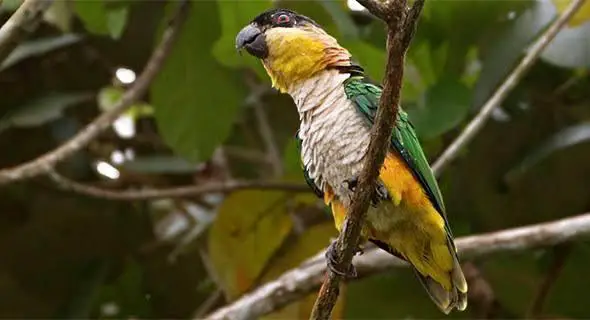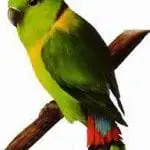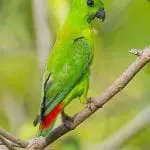Scientific Facts
| Common Name | Black-headed Parrot |
| Scientific Name | Points melanocephala |
| Origin | Amazon, particularly in the North Amazon River, northern Bolivia, west Ucayali River Brazin, Ecuador, Colombia, Guyana, French Guiana, Suriname, Peru, and Venezuela. |
| Habitat | In the forest and wooded tropical habitat mostly in lowland and humid areas. They situated up to 1000 meters of elevation in seasonally flooded woodland with scattered trees. They roost communally in holes in trees. |
| Diet | almost all flowers they see nearby as well as its seeds and pulp; they also eat small insects that go near their place or habitat |
| Size and Weight | Size: 9-9.2 inches (23-25 centimeters) Weight: between 130-170 grams (4.5-6 oz) |
| Lifespan | 27-40 years |
Physical Description
The black-headed parrot, also known as the pallid parrot and black-headed caique, is characterized to have a small-medium body with a short tail. It has a yellow to orange head with a black crown and forehead. Like other parrots, it also has a whitish belly, yellow crissum and thighs, blue primaries, greyish-black bill and feet, and green wings, back, and tail.
Its feathers are white with stains of chestnut brown color; some experts believe that these stains on their feathers are a result of rubbing their bodies into wet leaves and other plant material when they are bathing. Both males and females look identical; that is why the only way to know their gender is through DNA testing. The black-headed parrots have a distinct marking; that is why they are also called the seven-color parrot.
Where it is Seen?
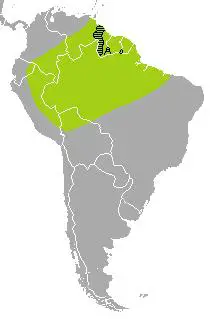
The black-headed parrot thrives mostly in the Amazon, particularly in the North Amazon River, northern Bolivia, west Ucayali River Brazil, Ecuador, Colombia, Guyana, French Guiana, Suriname, Peru, and Venezuela. Due to different efforts to conserve this species, it commonly occurs in protected areas.
Habitat
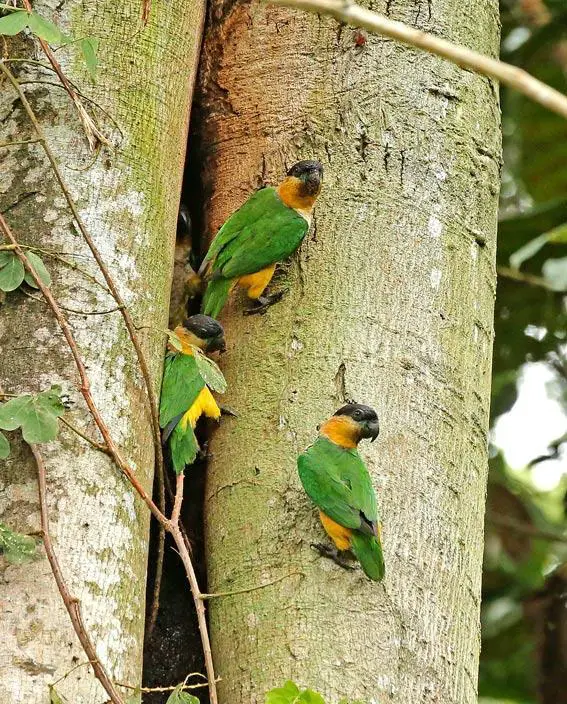
The black-headed parrot is seen in the forest and wooded tropical habitat, mostly in lowland and humid areas. They situated up to 1000 meters of elevation in seasonally flooded woodland with scattered trees. They roost communally in holes in trees. During the spring and summer season, they are mostly seen in woodlands and tall mountain forests that are highly timbered. During the winter and autumn season, they would go to lower altitudes for them to keep their bodies drier in open forest, usually in coastal areas in urban places. Their nests are located in hollows, which have at least 10 cm in diameter 9m above the ground of the tree where they are in.
Behavior and Temperament
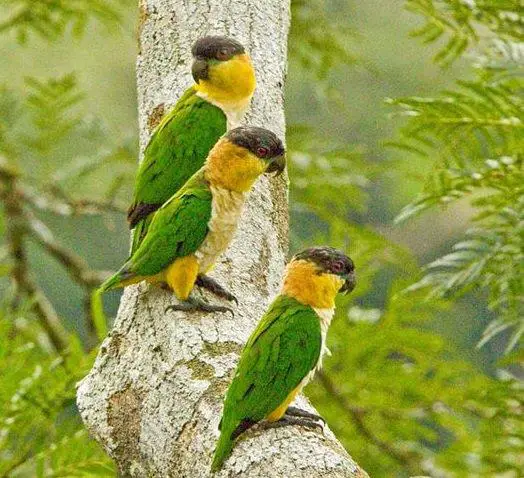
The black-headed parrot usually seen flocks up to 10-30 birds, they tend to be noisy when they are in small flocks. Their calls are often heard early in the morning as a form of their greeting displays while raising their wings. They may poorly mimic human speech, but they can easily mimic environmental sounds such as microwave-oven, beeps, car alarms, whistles, and laughing. They often combine the sounds that they hear to form new sounds.
They are territorial that may exhibit their aggressive tendencies when they feel threatened through biting, but most of the time, they will only bite if they lose balance during training because it is a way for them to hold on. Their intelligence gives entertainment; they also have an outgoing, acrobatic, fun, and lovable personality making them perfect captive and loyal pets. They are also known as a dancing parrot since they hop and move around a lot like they are dancing, especially when they hear rhythmic clapping. They are naturally curious about exploring new things around them so that they won’t be bored.
Behavioral Problems
The black-headed parrots also exhibit behavioral problems such as excessive chewing that they chew anything that they see even electrical wirings, especially when they discover the uses of their beaks when they reach maturity. They are known as a noisy parrot species, but in some cases, they scream a lot, especially when they are seeking attention, a way to discipline them is to cover their cage with a cloth until they keep quiet. Another behavioral problem that they have is to pluck their feathers when they are bored and stressed; that is why a way to avoid this problem is to always give them time to play and bond with them every day.
Breeding and Reproduction
The black-headed parrot reaches sexual maturity when they reach the age of three; the mating season runs from November to February. Like other parrot species, they build their nest in a high tree, which they guard aggressively from larger birds like toucans that feed on other bird’s eggs and juveniles. The females lay about 3 to 4 clutches of eggs with an average length of about 1.46 by 1.18 in (37.1-by-29.9-millimeter).
Both males and females can take turns incubating the eggs for 25-27 days, depending on the temperature. The juveniles look totally the same with only white coloration all over their bodies, but it slowly changes within the week. Their wing will start to develop by the time they reach their 4th week, and they are ready to fly when they are about 70-80 days. Both males and females take turns in taking good care and feeding their young, but as soon as their wings show off, they’ll still abandon them.
Diet
The black-headed parrot in the wild feed in almost all flowers they see nearby, as well as its seeds and pulp. They also eat small insects that go near their place or habitat.
Size and Weight
The Black-headed parrot has often compared with the white-bellied caique, but the black-headed caique looks slightly smaller. They have an average length of 9 – 9.2 inches (23-25 centimeters) with a weight between 130-170 grams (4.5-6 oz).
Lifespan
There is no recorded lifespan in the wild, but experts had estimated that they could live for about 27 years in the wild and up to 40 years in captivity.
Common Diseases/Illnesses
- Malnutrition
The Black-headed parrot is mostly prone to Vitamin K and calcium deficiency that leads to feather loss, brittleness, and malformation of beaks and nails, and it may also lead to sudden death. When your bird has malnutrition, they may become infertile and that their eggs may be soft-shelled. Having a poor diet is the most common reason why malnutrition is prevalent, especially for captive birds.
If you do not see any problems with the food that you are giving to your pet, there is a possibility that there is something wrong with the food combinations and the way how the bird absorbs it; that is why you may need to seek guidance from your veterinarian. Always make sure that before changing or shifting the diet of your bird with a different menu, you may need to consult your veterinarian first.
- Polyomavirus
This is an infectious disease that infests most aviary, especially the juveniles, because they haven’t produced enough immunity against this disease. It is fatal because it directly impacts the antibodies in their body that slowly weakens their immunity. The healthy the bird is, it is less likely that it will be affected. Research shows that this disease impacts the juveniles more than the adults because the juvenile’s body is still weak. When one bird has polyomavirus, it can be transmitted to other birds immediately, but good thing it is not transferable to humans. A way to avoid the disease to spread is to separate or quarantine the bird that looks weak immediately.
Among the parrot species, the conure species are the ones that are more prone to polyomavirus. There is no cure for this disease, but there is a vaccination to be given before the bird develops its wings to ensure that the immunity of the bird to fight this disease is sufficient. These are the symptoms of polyomavirus diarrhea, dehydration, vomiting, loss of appetite, swollen abdomen, and sudden weight loss. Do not wait for a few more days before taking it to a veterinary or before taking the bird to quarantine because the disease can be spread in just minutes, so you need to be observant.
- Pacheco’s disease
This disease is caused by another virus, which is the herpes virus that is highly contagious to other animals, but good thing it is not transmittable to humans. This can be transmitted easily to other birds through nasal discharge and bird’s feces. When the bird acquired this disease, it can be fatal, especially when the bird’s immunity is low. Even though humans won’t get this disease, they can be a carrier, so be cautious in handling them before handling other birds.
There are manifestations to know if your bird is infected with this disease, and the common side effects are the most common manifestation of this disease is sudden death. Some bird infested experiences green dropping, tremors, and anorexia. When it is detected at an early stage, it can still be cured through the use of an antiviral drug, but this drug has side effects that can damage the bird’s kidneys in a short span of time. Quarantine is used as the safest preventive measure to avoid the disease from spreading further.
- Salmonella
This is common for feeder birds wherein the bacteria comes from an intestinal-tract infection. If your bird is infected, your child may experience ruffled feathers and diarrhea. As soon as you see these symptoms, take your bird to a veterinarian because usually, this disease can kill them for about 3 days only. If you place more than 1 bird in a cage, remove the infected ones because this disease can spread rapidly. Salmonella is also transmittable to humans, so be sure to wear protective gear.
- Trichomoniasis
This is caused by a cell called protozoa, which are infected. This is a disease that infects almost all bird species. This disease is evident through the sores in their throat and mouth, and they do not have an appetite for food because of the inability to swallow. When a particular infested bird drops the food from its mouth, and other birds feed on it, except that the disease will be transmitted easily.
- Aspergillosis
This is a fungal infection that comes from an unsanitary environment where the bird is exposed to wet nesting materials and contaminated food. Your bird will have respiratory illnesses such as bronchitis and pneumonia due to the inhaled spores. If you notice that your bird experiences labored breathing, diarrhea, and weaknesses, take them out and for diagnosis.
- Giardia
This is an intestinal infection caused by a microscopic parasite that causes abdominal and digestive problems to the bird. It is caused by an unsanitary environment, and if the food and water that are given to them are not clean. A bird that is infested by this parasite shows symptoms of itchiness of their whole body, dry skin that may lead to feather picking, bulky stools, diarrhea, and depression.
The parasites can live in the intestines of the bird for weeks, and it can form cysts that are shed through their feces. When your bird is infested, the disinfection of all the things used by the bird is necessary, such as their toys, perches, water and food bowl, as well as the whole cage. The infected bird should also be given antibiotics to kill the parasites.
- Psittacine beak and feather disease (PBFD)
This happens when the immune system and the cells that take good care of the beak and feathers are attacked by the virus. You know that your bird is suffering from this disease if the feathers change in color and if the feathers are dropping while the beak changes in shape and is fragile. This disease doesn’t have a known cure; that is why some birds who are suffering from this disease have a weakened immune system that is the cause of their death. It is important to let your bird be screened for PBFD before taking it into captivity.
- Food poisoning/Ingesting toxins
Whether in the wild or in captivity, cockatoos are susceptible to food or toxin poisoning. Not all types of food are healthy to them; there are the kinds of foods that are toxins and may cause negatively on their health, such as avocados, grapes, peanuts. If your cockatoo ingested these toxic foods, they might suffer from the normal real stool, dizziness, liver disease, kidney problems, and heart failure. Inhaling toxic household chemicals is also dangerous for their health; that is why it is advisable not to use any household chemicals near them.
- Ulcerative dermatitis
This is a skin disease that can easily irritate the parrot. A sign that they are irritable is when they peck their skin that eventually leads to wounds and breakage. It brings itchiness and stinging sensations. When you see that your parrot has an open wound, make sure to do first aid so that it won’t be infected. There are ointments that can ease irritations. Your bird can be prone to different bacterial infections if this disease is not treated immediately due to the open wounds that they may get.
- Overweight parrot
Most conures that are taken into captivity are susceptible to obesity due to incorrect diet and since they only have a limited exercise. When they are obese or overweight, difficulty in breathing, stressed joints, and bones are experienced, and they are also prone to having diabetes, liver disease, and pancreatic disease. Benign fatty tumors, or known as lipomas, are another manifestation of obesity. This tumor is painful, especially when it grows large, and the only way to remove it is through surgery, which is quite risky for your pet.
Choose healthy food options for your bird, so there will be no chances that they’ll have weight problems. If they are physically fit, they can move freely, making them healthy and less prone to diseases. You may consult your veterinarian about the specific diet that you need to give your bird. There are foods that you should avoid to give them, such as sugary and fatty foods.
- Bumblefoot
This is characterized by swelling and lameness of the cockatoo’s feet and is usually consists of lesions with a discharge. If your bird suffers from this condition, expect that they will have difficulty to land on the ground, stand on the porch, or even grasp their food or toys. Since the swelling of their feet is accompanied by lesions, make sure that their cage is hygienic to avoid infections. Bumblefoot is usually due to malnutrition, especially when there is Vitamin A or calcium deficiency.
- Feather Picking and Self-mutilation
Feather Picking and self-mutilation are usually due to behavioral problems caused by boredom, stress, and sexual frustration. As soon as your bird learns this behavior, it can no longer be unlearned; that is why when you notice unusual behavior from your bird, take it immediately to your veterinarian. This behavior is usually triggered if your bird is lonely and bored; that is why it is always important to make them feel that they are not alone by playing with them, or you can have them in pairs.
Preventing Illness
The black-headed parrot has the ability to have a strong immunity as long as the conditions are right. In captivity, different factors such as the housing, temperature, substrate, accessories, and handling should be taken into consideration to ensure that the parrot will live happily and healthily. There is no perfect environment for parrots, but there is an optimal condition where they can live longer.
The different diseases or illnesses that infest them is a big factor that affects their lifespan. You need to observe thoroughly that the energy of the parrot is consistent every day, if there is a detrimental change in how they behave, it means that there is something wrong that is why you need to be more attentive on how to deal with their concerns.
Captive Breeding
The black-headed parrot is a good family pet, but you may need to place it in a sound-proofed area if you are quite sensitive to noise because they can create sounds that they mimic from their environment loudly during their past time. The black-headed parrot is naturally shy; that is why even if you have captivated them for a long time, this is the trait that is quite difficult to change. You may need to purchase at least two black-headed parrots since they are sociable, there is a tendency that they’ll become lonely when left alone
During the first week of their captivation, it is not advisable to handle them frequently, give them time to become familiar with their new environment first so that it would be easier for you to tame them. This is a parrot species that is not complicated to take into captivity, but you still need to make sure that their basic needs are met and that it is a bird species that is more suitable for experienced bird growers. They can be taught tricks easily as long as you have the patience and passion for doing it.
Availability-Where to Get One?
They still have a sufficient population in the wild; that is why it is easier to acquire them for captive breeding. They can be acquired through different pet shops, and they are commonly bred by personal breeders through online transactions.
How to Care Parrot as a Pet?
- Housing
The black-headed parrots need to stay in a large cage filled with lots of toys and perches. An ideal cage for them has dimensions of 24″ L X 24″ W X 36″ H or larger. If you intended to place the cage in a separate room, it is best to also make the atmosphere comfortable for the bird by painting it with fun colors but make sure that before placing the bird in a newly painted walls, the room is already free from any paint smell so as not to harm the bird. It is better to use a paint that is organic and has all-natural ingredients. Make sure that the place where they are should have a temperature, not 90 degrees Fahrenheit and not decreasing into 50 degrees Fahrenheit.
- Accessories
Aside from their cage that has the right dimensions, it is also important to give attention to the different accessories that you will place in the cage. You may need to at least provide an environment for them where their natural environment is somehow mimicked. The perches are one of the most important accessories in their cage because it is where they spend most of their time if they are sleeping, resting, and playing.
The perches can be made from a rope, wood, or PVC. Grooming is a part of caring for your bird; if you do not have sufficient time to trim their beaks and nails, you must place a sandy and concrete area in the cage where they can rub off their nails and beaks to shape it up. To prevent them from being stressed, frustrated, and bored, choose toys that are safe for them. The food and water bowls that you should give them should always be clean at all times; if there are any leftovers, remove it immediately and do not let your parrot eat any leftovers from their meal the day before because it might cause some digestive problems.
- Feeding
The black-headed parrot has a wide range of food selection in captivity; they can either eat pelleted mixes, fresh food, or a combination of pelleted mixes and fresh food depending on the availability of food for them. If you would consult a veterinarian, they may advise you to use a formula diet since that is enriched with nutritional value that your pets need to grow healthily. You may also support their intake of vitamins and minerals through the use of supplements or cuttlebone, especially to fight Calcium and Vitamin A deficiency.
- Exercise
The black-headed parrot is an active bird, may it be to flying, playing, eating, and even walking. Others say that this bird often prefers walking than flying. In captivity, it is ideal to at least give your parrot one hour outside its cage to strengthen its leg muscles by means of exploring quite long distances by flying, walking or hopping. The muscles should not be only exercised but the beak as well, they can do this through the help of chewable toys that they can play around with using their beaks. The toys and perches on their cage should be checked regularly to change worn-out things so that all things surrounding your bird are still in good working condition.
Conservation Status
The black-headed parrot’s population may be decreasing, but it is not known to sufficiently lead to having a population threshold for Vulnerable status. Their population is still fairly common in its range, and they are not yet threatened. However, there are still reasons that may contribute to the degradation of their population, such as illegal hunting and marketing, destruction of their habitat due to climate change, natural disasters, and man-made causes.
FAQ Section
Are black-headed parrot loud?
The black-headed parrot is one of those parrots that produce loud shrieks and alarm calls; that is why if you are living in an apartment or in a small place, think twice about considering to pet this parrot species.
Do black-headed parrot bite?
This parrot species is not usually aggressive that leads to biting, but if in any case your bird suddenly bites you during a play, there is a possibility that this is just its way to balance itself, so just give them a toy or a perch where they can balance and bite.
Are black-headed parrot good pets?
They may not be friendly too with other bird species, but they can easily form unique bonds with their owners, especially if they are loved and when they felt adequate affection and attention. They love playing with humans; that is why it is quite easy to train them in different kinds of tricks.
Can black-headed parrot talk?
They can loudly do whistles and cluck, but they are not known to be good talkers and mimickers like other parrots, but with proper training, you can let them utter few words.
Do black-headed parrots get along with other birds?
The black-headed parrot does not usually mingle with other bird species unless they were put together in one cage at the same time but when it comes to other birds of the same species, except that they can get along well because, in the wild, they love to stay in a flock.
Why does my black-headed parrot pluck its feathers out of its chest?
When your parrot plucks its feathers, especially on the chest, if they are bored, stressed, and unhappy. Make sure your bird doesn’t get this behavior because when they learn this habit, it can no longer be broken.
Can I keep my black-headed parrot under the sun?
Daylight is necessary for their digestive functioning and for them to be healthy, but direct exposure is not advisable because they can be prone to hyperthermia. If you place them outdoors, make sure that they are not too exposed to sunlight, especially at noontime.
Do black-headed parrots need a lot of attention?
They need a lot of attention, especially in captivity; that is why before choosing to take good care of them, make sure that you have enough time for them. If they get bored, there are high chances that they will develop bad habits.
Can two black-headed parrots work well in a pair?
They work well with a pair because boredom, stress, and frustration are common to parrots who live alone. If you only intended to keep one bird, make sure that its cage is filled in with so many toys and perches to keep the bird busy.

